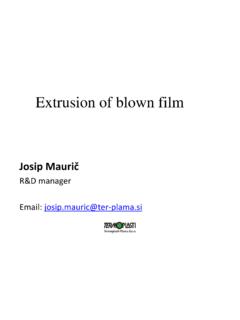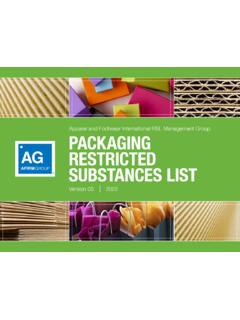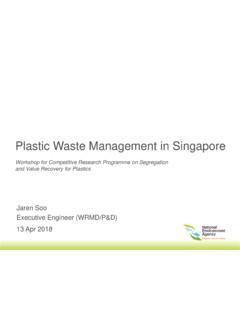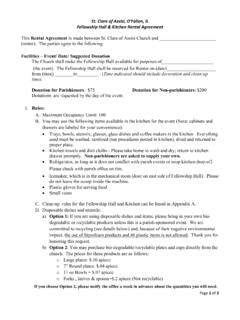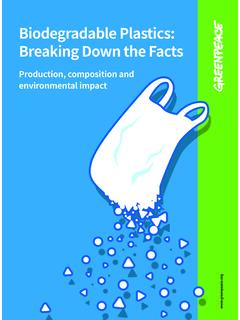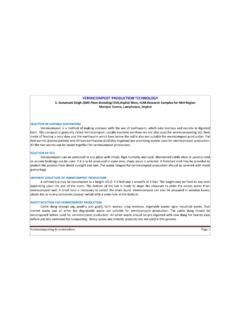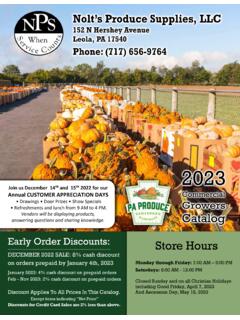Transcription of Bio-based and biodegradable plastics - Facts and Figures
1 Bio-based and biodegradable plastics Facts and Figures Focus on food packaging in the Netherlands Martien van den Oever, Karin Molenveld, Maarten van der Zee, Harri tte Bos Rapport nr. 1722 Bio-based and biodegradable plastics - Facts and Figures Focus on food packaging in the Netherlands Martien van den Oever, Karin Molenveld, Maarten van der Zee, Harri tte Bos Report 1722 Wageningen Food & Biobased Research, institute within the legal entity Stichting Wageningen Research 2 Colophon Title Bio-based and biodegradable plastics - Facts and Figures Author(s) Martien van den Oever, Karin Molenveld, Maarten van der Zee, Harri tte Bos Number Wageningen Food & Biobased Research number 1722 ISBN-number 978-94-6343-121-7 DOI Date of publication April 2017 Version Concept Confidentiality No/yes+date of expiration OPD code OPD code Approved by Christiaan Bolck Review Intern Name reviewer Christaan Bolck Sponsor + Dutch Ministry of Economic Affairs Client + Dutch Ministry of Economic Affairs Wageningen Food & Biobased Research Box 17 NL-6700 AA Wageningen Tel: +31 (0)317 480 084 E-mail: Internet: Wageningen Food & Biobased Research, institute within the legal entity Stichting Wageningen Research All rights reserved.
2 No part of this publication may be reproduced, stored in a retrieval system of any nature, or transmitted, in any form or by any means, electronic, mechanical, photocopying, recording or otherwise, without the prior permission of the publisher. The publisher does not accept any liability for inaccuracies in this report. Wageningen Food & Biobased Research, institute within the legal entity Stichting Wageningen Research 3 Preface For over 25 years Wageningen Food & Biobased Research (WFBR) is involved in research and development of Bio-based materials and products. Examples of materials and products developed include bioplastics for packaging, casings for consumer electronics, textiles and parts for the automotive industry.
3 A unique aspect of the work of WFBR is our broad and detailed knowledge of the full production chain, from the biomass to Bio-based materials, and of collection and recycling of plastics . Next to our technological knowledge, we also focus on sustainability, logistics, economics, normalisation and end-of-life options. We take part in a number of normalisation committees. Also we have done several studies on plastics collection and recycling. In recent years, we have contributed to a wide range of projects for both industry and governments. For that reason WFBR has been asked by to collect Facts and Figures on technical, economical and sustainability aspects of Bio-based and biodegradable plastic food packaging and present them in a scientific overview report.
4 This report builds on previous publications such as Biobased plastics 2012 and the Catalogue Biobased Packaging and addresses unclear and contradictory information present in society regarding Bio-based and/or biodegradable plastics . On request of the Dutch Ministry of Economic Affairs, the target audience of this report is the Dutch retail sector and consumers. Parallel to this report, the Ministry of Infrastructure & the Environment (I&M) has commissioned CE Delft to prepare a report on the conditions under which Bio-based and/or biodegradable plastics are compatible with the circular economy. The focus of the CE Delft report is on greenhouse gas (GHG) balance and the use of (natural) resources throughout the life cycle.
5 Reader s Guide Throughout the report, typical questions from consumers and also from retailers and other professionals related to Bio-based and biodegradable plastics have been highlighted in text boxes. In the subsequent text Facts and Figures are presented to address these questions. Several relevant aspects regarding Bio-based and biodegradable plastics are defined in the first chapter. In chapter 2, the appearance and recognition of these plastics are addressed. Next, Figures for the availability and costs of Bio-based and biodegradable plastics are presented in chapter 3. Their application and suitability for packaging of food is discussed in chapter 4, while end-of-life options for Bio-based and/or biodegradable plastic products with focus on post-consumer food packaging are reviewed in chapter 5.
6 Finally, several sustainability issues of Bio-based plastics are addressed in chapter 6, like its impact compared to fossil-based plastics , the food versus Bio-based plastics discussion, the use of genetically modified organisms for Bio-based plastic production and disposal in the environment. Wageningen Food & Biobased Research, institute within the legal entity Stichting Wageningen Research 4 Acknowledgements Our thanks go to Erwin Vink, Tim Brethouwer, Peter Besseling, Ulphard Thoden van Velzen and Christiaan Bolck for their contributions to the realisation of this publication, to the Netherlands Enterprise Agency ( ) and to the Ministry of Economic Affairs for financial support for this project (BO-20-012-026).
7 Disclaimer Facts and Figures have been collected from various reputable sources. Some of the Figures are more recent than others. We assume to the best of our knowledge that the information presented gives a truthful representation of the present situation, but we cannot take any responsibility for the accuracy of information provided. Bio-based and biodegradable plastics are a large family of materials with widely varying properties. As with conventional plastics , the end-of-life options depend entirely on the application, the way the product is disposed of by its user, and the available infrastructure in the region where the product is being disposed of. Wageningen Food & Biobased Research, institute within the legal entity Stichting Wageningen Research 5 Abstract This report presents an overview of Facts and Figures regarding Bio-based and/or biodegradable plastics , in particular for packaging applications.
8 Often, the term bioplastic is used by the public. However, the term bioplastic refers to either the Bio-based origin of a plastic or the biodegradable character of a plastic. These two aspects of a plastic are not synonymous, and therefore the term bioplastic is confusing. In this report a clear distinction is made between Bio-based and biodegradable plastics . Appearance and recognition Just like fossil based plastics , Bio-based and/or biodegradable plastics are available in many grades with a wide variety of properties. The suitability of Bio-based and/or biodegradable plastics for particular applications depends on these properties. A lso the most suitable end-of-life option depends on its properties.
9 However, Bio-based plastic products often have a very similar appearance compared to conventional fossil-based plastic products. As a consequence, they cannot be easily distinguished by consumers. The same is valid for biodegradable versus non- biodegradable products. Logo s and labels can be used to make clear to the consumer (and retailer) whether a plastic is Bio-based and/or compostable, and how to dispose of the plastic after use. Some qualifications like biodegradable are not unambiguously defined. Consequently, logo s and labels will need to be linked to a normalisation and certification system. Moreover, even when a plastic is biodegradable , this does by no means imply that the material degrades in the environment in a short period of time.
10 Availability and costs In 2015, the production capacities for Bio-based and biodegradable plastics account for nearly 1% of total global plastics production. The markets for some Bio-based and/or biodegradable plastics are expected to grow significantly during the coming years (Bio-PET, PBS and PLA), others are expected to consolidate (CA and Bio-PA). Overall, it is expected that by 2020 the share of Bio-based and biodegradable plastics will increase to of fossil plastics production. For most of the Bio-based and biodegradable plastics there are several suppliers and most plastics are readily available. In general, Bio-based and biodegradable plastics are more expensive than fossil-based plastics on a weight basis.


